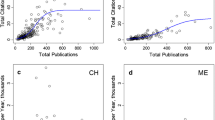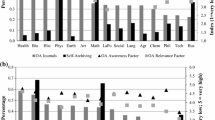Abstract
The use of bibliometric indicators in research evaluation makes many hidden assumptions about scientists' publishing habits. This paper tests an assumption that scientists are reward oriented and attempt to publish in as prestigious channels as possible, seeking an optimal level in the hierarchy of publications. The data are based on interviews with teaching and research personnel in four university departments in the fields of zoology, biomedicine, and automation and control technology. The author concludes that in all studied fields scientists placed equal emphasis on the reward and communication functions of publishing. The actual publishing behaviour of biomedical scientists, nevertheless, accorded best with the assumption of seeking an optimal level of publishing in terms of prestige. By contrast, in zoology and technical fields, local and field-related publishing habits appeared strong.
Similar content being viewed by others
Notes and references
R.K. Merton, Foreword. In:E. Garfield,Citation Indexing — Its Theory and Application in Science, Technology, and Humanities, John Wiley & Sons, New York, 1979, pp. vii-xi.
J.R. Ravetz,Scientific Knowledge and Its Social Problems, Oxford University Press, London, 1971, pp. 282.
W.D. Garvey, Social dimensions of science: The struggle between authors and editors,Journal of Research Communication Studies, 3 (1981) 257–271.
M.D. Gordon, How authors select journals: A test of the reward maximization model of submission behaviour,Social Studies of Science, 14 (1984) 27–43.
, pp. 267–8.
The concept of the evaluative state has been introduced byG. Neave, On the cultivation of quality, efficiency and enterprise: An overview of recent trends in higher education in Western Europe, 1986–1988.European Journal of Higher Education, 23 (1988) 7–23. It means public policy, in this case, university policy in which a regulation of higher education institutes is made by evaluation of their output.
Cf.Garvey, 1981,, pp. 267–8.
That there exist differences in formal communication between disciplines is a well established fact in communication research. SeeW.D. Garvey, N. Lin, C.E. Nelson, Some comparisons of communication activities in the physical and social sciences, In:C.E. Nelson, D.K. Pollack,Communication Among Scientists and Engineers, Heath Lexington Books; Lexington, 1970, pp. 61–84.
The project is called “Dynamics and Productivity of Academic Research”. See Acknowledgment.
Cf.A. Schubert, W. Glanzel, T. Braun, Scientometric datafiles. A comprehensive set of indicators on 2649 journals and 96 countries in all major science fields and subfields 1981–1985,Scientometrics, 16 (1989) 239.
.
.
The Academy of Finland is a research council organization which covers all fields of science.
In zoology, those in senior positions referred more often to US publications, and never to Finnish publications. In technology, those in senior positions referred more often to publications which were covered by theSCI.
K.D. Knorr, R. Mittelmeier, G. Aichholzer, G. Waller, Individual publication productivity as a social position effect in academic and industrial research units. In:F.M. Andrews (Ed.),Scientific Productivity: The Effectiveness of Research Groups in Six Countries, Cambridge University Press, Cambridge, 1979, pp. 55–94.
.
T. Luukkonen, Publish in a visible journal or perish? Assessing citation performance of Nordic cancer research,Scientometrics, 15 (1989) 349–367.
Evaluation of Scientific Research in Hydrobiology in Finland.Publications of the Academy of Finland 5/1986, Helsinki.
According toA.J. Meadows,Communication in Science, Butterworths, London, 1974, p. 61.
Author information
Authors and Affiliations
Rights and permissions
About this article
Cite this article
Luukkonen, T. Is scientists' publishing behaviour rewardseeking?. Scientometrics 24, 297–319 (1992). https://doi.org/10.1007/BF02017913
Received:
Issue Date:
DOI: https://doi.org/10.1007/BF02017913




